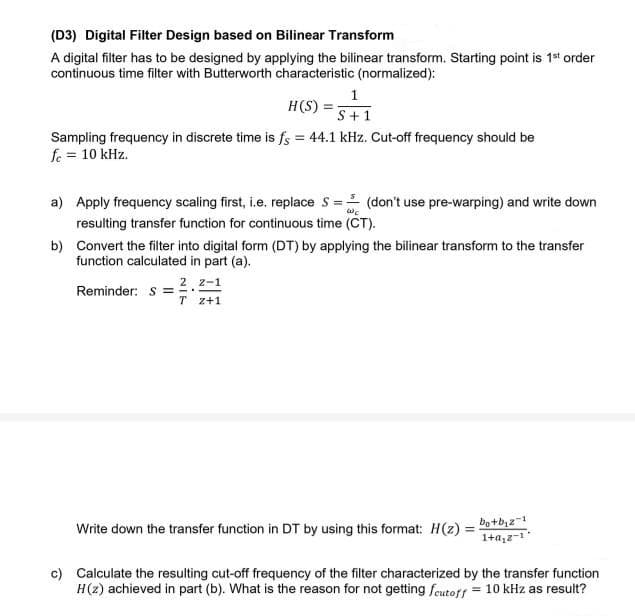(D3) Digital Filter Design based on Bilinear Transform A digital filter has to be designed by applying the bilinear transform. Starting point is 1* order continuous time filter with Butterworth characteristic (normalized): 1 H(S) = S+1 Sampling frequency in discrete time is fs = 44.1 kHz. Cut-off frequency should be fe = 10 kHz. a) Apply frequency scaling first, i.e. replace S = (don't use pre-warping) and write down resulting transfer function for continuous time (CT). b) Convert the filter into digital form (DT) by applying the bilinear transform to the transfer function calculated in part (a). 2 z-1 Reminder: S == T z+1
(D3) Digital Filter Design based on Bilinear Transform A digital filter has to be designed by applying the bilinear transform. Starting point is 1* order continuous time filter with Butterworth characteristic (normalized): 1 H(S) = S+1 Sampling frequency in discrete time is fs = 44.1 kHz. Cut-off frequency should be fe = 10 kHz. a) Apply frequency scaling first, i.e. replace S = (don't use pre-warping) and write down resulting transfer function for continuous time (CT). b) Convert the filter into digital form (DT) by applying the bilinear transform to the transfer function calculated in part (a). 2 z-1 Reminder: S == T z+1
Introductory Circuit Analysis (13th Edition)
13th Edition
ISBN:9780133923605
Author:Robert L. Boylestad
Publisher:Robert L. Boylestad
Chapter1: Introduction
Section: Chapter Questions
Problem 1P: Visit your local library (at school or home) and describe the extent to which it provides literature...
Related questions
Question
100%

Transcribed Image Text:(D3) Digital Filter Design based on Bilinear Transform
A digital filter has to be designed by applying the bilinear transform. Starting point is 1st order
continuous time filter with Butterworth characteristic (normalized):
1
H(S) =
S+1
Sampling frequency in discrete time is fs = 44.1 kHz. Cut-off frequency should be
fe = 10 kHz.
a) Apply frequency scaling first, i.e. replace S = (don't use pre-warping) and write down
resulting transfer function for continuous time (CT).
b) Convert the filter into digital form (DT) by applying the bilinear transform to the transfer
function calculated in part (a).
2 z-1
Reminder: s =
T z+1
Write down the transfer function in DT by using this format: H(2) = Do+bi2
1+a,z-1"
c) Calculate the resulting cut-off frequency of the filter characterized by the transfer function
H(z) achieved in part (b). What is the reason for not getting feutoff
= 10 kHz as result?
Expert Solution
This question has been solved!
Explore an expertly crafted, step-by-step solution for a thorough understanding of key concepts.
Step by step
Solved in 4 steps

Knowledge Booster
Learn more about
Need a deep-dive on the concept behind this application? Look no further. Learn more about this topic, electrical-engineering and related others by exploring similar questions and additional content below.Recommended textbooks for you

Introductory Circuit Analysis (13th Edition)
Electrical Engineering
ISBN:
9780133923605
Author:
Robert L. Boylestad
Publisher:
PEARSON

Delmar's Standard Textbook Of Electricity
Electrical Engineering
ISBN:
9781337900348
Author:
Stephen L. Herman
Publisher:
Cengage Learning

Programmable Logic Controllers
Electrical Engineering
ISBN:
9780073373843
Author:
Frank D. Petruzella
Publisher:
McGraw-Hill Education

Introductory Circuit Analysis (13th Edition)
Electrical Engineering
ISBN:
9780133923605
Author:
Robert L. Boylestad
Publisher:
PEARSON

Delmar's Standard Textbook Of Electricity
Electrical Engineering
ISBN:
9781337900348
Author:
Stephen L. Herman
Publisher:
Cengage Learning

Programmable Logic Controllers
Electrical Engineering
ISBN:
9780073373843
Author:
Frank D. Petruzella
Publisher:
McGraw-Hill Education

Fundamentals of Electric Circuits
Electrical Engineering
ISBN:
9780078028229
Author:
Charles K Alexander, Matthew Sadiku
Publisher:
McGraw-Hill Education

Electric Circuits. (11th Edition)
Electrical Engineering
ISBN:
9780134746968
Author:
James W. Nilsson, Susan Riedel
Publisher:
PEARSON

Engineering Electromagnetics
Electrical Engineering
ISBN:
9780078028151
Author:
Hayt, William H. (william Hart), Jr, BUCK, John A.
Publisher:
Mcgraw-hill Education,